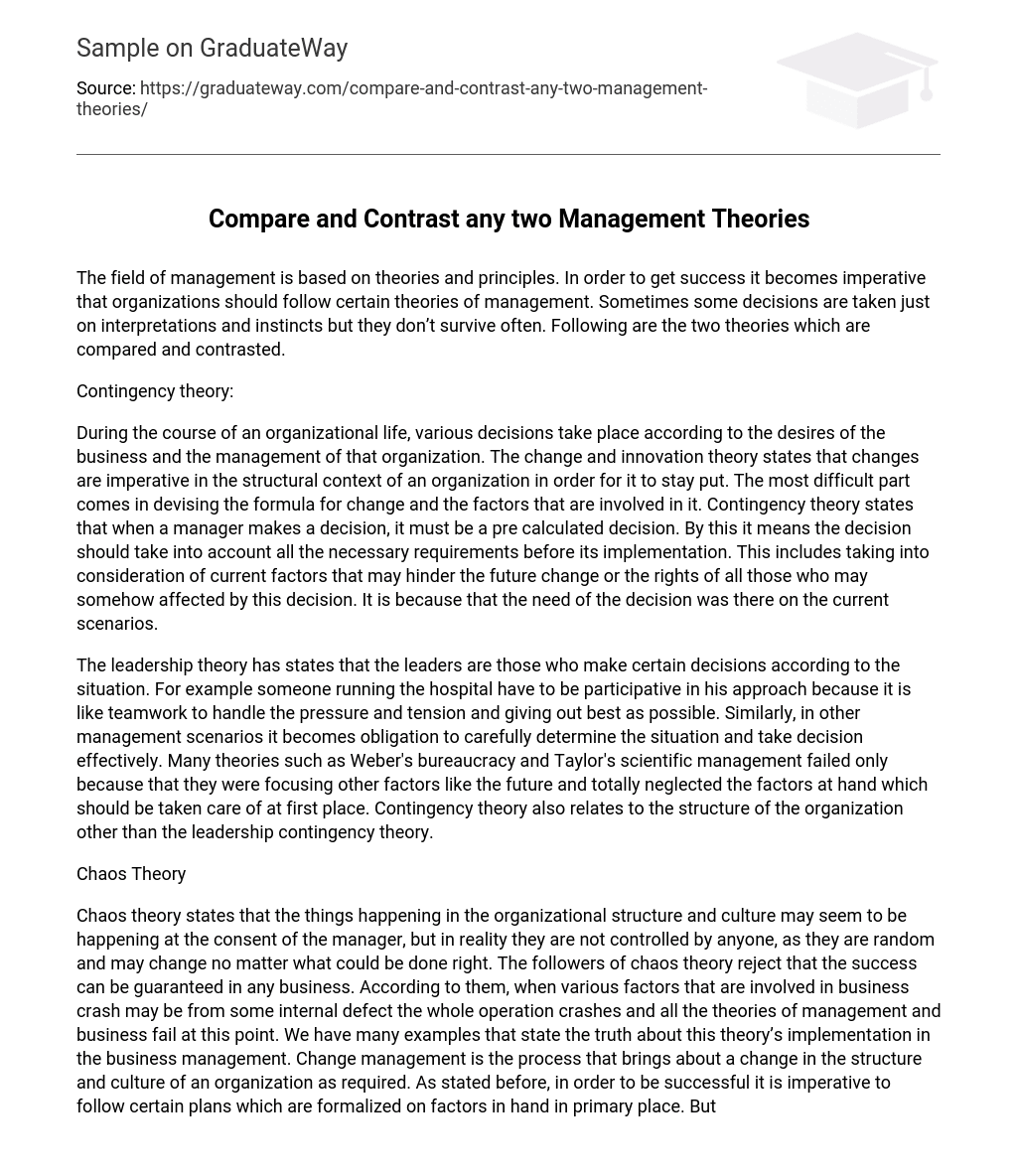The field of management is based on various theories and principles. In order to achieve success, it is imperative for organizations to follow certain management theories. Although some decisions may be made based on interpretations and instincts, they often do not succeed in the long run. The following two theories will be compared and contrasted:
Contingency theory is a management approach that suggests there is no one-size-fits-all solution to managing an organization. Instead, the most effective management style and decision-making process depend on the specific situation at hand. This theory recognizes that different situations require different approaches and encourages managers to be flexible in their leadership style.
During the course of an organization’s life, various decisions are made according to the desires of the business and its management. The change and innovation theory states that changes are necessary in the structural context of an organization in order for it to remain relevant. The most challenging part is devising a formula for change and identifying all factors involved. Contingency theory states that when a manager makes a decision, it must be pre-calculated, taking into account all necessary requirements before implementation. This includes considering current factors that may hinder future change or affect those impacted by the decision. It is crucial to consider current scenarios when making decisions.
The leadership theory states that leaders are those who make decisions based on the situation at hand. For example, someone running a hospital must take a participative approach because it is like teamwork to handle pressure and tension and give their best possible outcome. Similarly, in other management scenarios, it becomes an obligation to carefully determine the situation and make effective decisions. Many theories such as Weber’s bureaucracy and Taylor’s scientific management failed only because they focused on other factors like the future and neglected the factors at hand that should be taken care of first. Contingency theory also relates to the structure of the organization, in addition to leadership contingency theory.
Chaos Theory
Chaos theory states that the events occurring in an organizational structure and culture may appear to be under the control of a manager, but in reality, they are random and can change regardless of any efforts made. Followers of chaos theory reject the notion that success can be guaranteed in any business. They believe that when various factors involved in a business fail, it may be due to some internal defect causing the entire operation to crash, rendering all management and business theories ineffective.
There are numerous examples that demonstrate how this theory applies to business management. Change management is a process that brings about changes in an organization’s structure and culture as required. To achieve success, it is essential to follow formalized plans based on primary factors at hand. However, we must examine why this change was necessary in the first place. If previous management theories were successful before and every step taken was according to current demands, then why do these actions now require change?
This question highlights how major management theories have limited functionality. When managers make decisions or propose changes within their businesses, they merely convey their viewpoints or desires for what they want to see happen within their company.
They formalize a plan and take action accordingly only to discover later on that their approach was incorrect or unsustainable over time if successful initially. Randomization is a natural phenomenon where things become more complex or more straightforward from time-to-time without warning.
The controlling factor can affect the current situation but will provide long-lasting effects rather than immediate results; thus systems may join with another system for better outcomes or split up entirely resulting in total failure for businesses.
The chaos theory and contingency theories are two important theories in general business management. Each theory has its own strengths and weaknesses. Contingency theory is highly effective in starting and running a business over time, while chaos theory rejects this approach by stating that no theory can guarantee the success of any business. Contingency theory requires that every change and decision follow a certain pattern to avoid problems with the factors at hand. In contrast, chaos theory states that taking into account current factors may change the organization’s stature, provide benefits, but ultimately lead to collapse due to natural phenomena.In real scenarios, we have seen many organizations stumble down following successful management theories including contingency theory. These changes were implemented because they provided immediate benefits to the organizations but were not profitable for long-term sustainability. The recent economic crisis provides us with an example where Citigroup followed their plans to maximize profits in less time by investing in real estate. While this seemed like a good idea according to contingency theory, it ultimately led to market crashes and losses.Chaos theory suggests that natural phenomena cause things to shape up differently than expected leading businesses towards failure over short periods of time. Both these theories are highly implemented in management principles; contingency operates during Change Management processes while chaos represents itself as any mishap occurring within an organization.
References
Lenskold, James D. (2003). The Path to Campaign, Customer, and Corporate Profitability. New York: McGraw-Hill Professional.
Peters, Tom. (1988). Thriving on Chaos: A Handbook for Management Revolution. New York: Harper Paperbacks.
Kast, Fremont E. and Rosenzweig, James E. (1985) wrote a book titled Organization and Management: A Systems and Contingency Approach” which was published by the McGraw-Hill Companies in New York.





